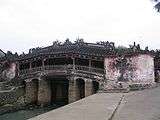Japanese people in Vietnam
|
Japanese red seal ship sailing out of Nagasaki for Annam (Vietnam) | |
| Total population | |
|---|---|
| 9,468 (2009)[1] | |
| Regions with significant populations | |
| Hanoi, Ho Chi Minh City | |
| Languages | |
| Vietnamese · Japanese | |
| Religion | |
| Buddhism · Shinto | |
| Related ethnic groups | |
| Japanese diaspora |
The community of Japanese expatriates and descendants in Vietnam consist mainly of Japanese expatriates and migrants residing in Vietnam, as well as their descendants who identify their ancestry to be Japanese. As of 2009, there are about 9,468 Japanese residents in Vietnam, mostly around the Hanoi area.
History
Early history

For a brief period in the 16th to the 17th centuries, Japanese overseas activity and presence in Southeast Asia and elsewhere in the region boomed. Sizeable Japanese communities, known as Nihonmachi, could be found in many of the major ports and political centers of the region, where they exerted significant political and economic influence.[2] One of which was Hội An in Nguyễn, Southern Vietnam.[3] The Japanese community there was quite small, consisting of only a few tens of households.[4]
Over the course of the 17th century, the Japanese community in Hội An gradually shrank and disappeared, assimilated into the Vietnamese community. Intermarriage not only within the Nihonmachi, but between notable Japanese merchant families and the Nguyễn noble family, is indicated by contemporary records, grave markers, and various forms of anecdotal evidence. The descendants of several of these merchant families still hold today as heirlooms objects relating the families' connections to Vietnam.[5]
Modern era
During World War II, on September 22, 1940, Japan invaded Vietnam and began constructing military bases to strike against the Allies in Southeast Asia. Japanese troops remained in Vietnam until their surrender to the Allies in 1945.
In recent years, many natives of Japan have migrated to Vietnam, mostly to Hanoi for all sorts of reasons. Chief among the professional lures are construction management, manufacturing and financial services jobs. Japan-owned Toyota, Honda and Canon have large manufacturing plants on the outskirts of Hanoi. Outside of business, Japanese foreign aid services and management are also a draw. Japan is currently the largest international donor to Vietnam. According to the Japan Foundation, Hanoi is home to under 5,000 Japanese residents.[6]
Education
There are two Japanese international schools:
The Ho Chi Minh City Japanese Supplementary School, a supplementary programme, is held in Ho Chi Minh City.[9]
See also
References
- ↑ Ministry of Foreign affairs of Japan - Socialist Republic of Viet Nam
- ↑ Wray. p8.
- ↑ Woodside. p162.
- ↑ A 1642 report to the Dutch East India Company by a Japanese inhabitant of the port describes a Chinese population of 4,000-5,000 and a Japanese population of 40-50. (Laarhoven, Ruurdje (trans.) "A Japanese Resident's Account: Declaration of the Situation of Quinam Kingdom by Francisco, 1642." in Li and Reid (eds.) Southern Vietnam. p31.)
- ↑ Chuong, Thau. "Bridge of Friendship." in Ancient Town of Hoi An. p209.
- ↑ wordhcmc.com - Little Japan
- ↑ Home. The Japanese School of Hanoi. Retrieved on February 13, 2015. "HAM NGHI, MY DINH 2, NAM TU LIEM, HA NOI"
- ↑ Home. The Japanese School in Ho Chi Minh City. Retrieved on February 13, 2015.
- ↑ "アジアの補習授業校一覧(平成25年4月15日現在)" (Archive). Ministry of Education, Culture, Sports, Science and Technology. Retrieved on February 13, 2015.
